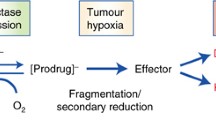Summary
RSU 1069 is a leading compound in the class of mixed-function hypoxic cell sensitizers. Possessing an alkylating aziridine function as well as a nitro group, it represents an important prototype molecule for new sensitizer development. Using a novel HPLC assay for RSU 1069 and its metabolites with a cyanopropyl column, we studied the detailed pharmacokinetics and metabolism of this drug in mice. An i.v. dose of 100 mg kg-1 produced peak plasma concentrations of about 100 μg ml-1. Absorption was rapid after i.p. injection but peak plasma, concentrations were some three- to fourfold lower, giving an i.p. bioavailability of 55%. The elimination t1/2 was route-dependent; e.g. after 50 mg kg-1 the t1/2 was 37.2 and 22.4 min for the i.v. and i.p. routes respectively (P<0.001). There was also an indication of dose-dependent kinetics, with a 37% increase in elimination t1/2 when the i.p. dose was doubled from 50 to 100 mg kg-1. Oral bioavailability was low. The volume of distribution was 0.65–1.31 ml g-1 at 50 mg kg-1, but tissue penetration was limited. Brain/plasma ratios ranged from 9.3% to 66.8%, while the mean steady-state tumour/plasma ratio was 28.4%, a value considerably less than the 80%–100% ratios occurring with the neutral 2-nitroimidazole misonidazole. About 18% and 8% of a dose were excreted as the parent drug and the ring-opened hydrolysis product (RSU 1137) in the 8 h urine, indicating the likelihood of extensive metabolism via aziridine-ring remooval and nitroreduction. RSU 1137 was also detected in mouse plasma and tissues and, in contrast to the aziridine ring-intact parent compound, gave tumour/plasma ratios of 100%. These studies should provide a pharmacokinetic basis for the evaluation and development of improved mixed-function sensitizers.
Similar content being viewed by others
References
Adams GE, Ahmed I, Sheldon PW, Stratford IJ (1984) RSU 1069, a 2-nitroimidazole containing an alkylating group: high efficiency as a radio- and chemosensitizer in vitro and in vivo. Int J Radiat Oncol Biol Phys 10: 1653
Adams GE, Ahmed I, Sheldon PW, Stratford IJ (1984) Radiation sensitization and chemopotentiation: RSU 1069, a compound more efficient than misonidazole in vitro and in vivo. Br J Cancer 49: 571
Ahmed I, Jenkins TC, Walling JM, Stratford IJ, Sheldon PW, Adams GE, Fielden EM (1986) Analogues of RSU 1069: radiosensitization and toxicity in vitro and in vivo. Int J Radiat Oncol Biol Phys 12: 1079
Deacon JM, Holliday SB, Ahmed I, Jenkins TC (1986) Experimental pharmacokinetics of RSU 1069 and its analogues: high tumour/plasma ratios. Int J Radiat Oncol Biol Phys 12 1087
Dvorchik BH, Vesell ES (1978) Significance of error associated with the use of the one-compartment formula to calculate clearance of thirty-eight drugs. Clin Pharmacol Ther 23: 617
Hill RP, Gulyas S, Whitmore GF (1986) Studies of the in vivo and in vitro cytotoxicity of the drug RSU 1069. Br J Cancer 53: 743
Horwich A, Holliday SB, Deacon JM, Peckham MJ (1986) A toxicity and pharmacokinetic study in man of the hypoxic-cell radiosensitizer RSU 1069. Br J Radiol 59: 1238
Murray D, Meyn RE (1985) DNA damage in normal and neoplastic mouse tissues after treatment with misonidazole in vivo. Biochem Pharmacol 34: 3275
Schwartz DE, Hofheinz W (1982) Metabolism of nitroimidazoles. In: Breccia A, Cavalleri B, Adams GE (eds) Nitroimidazoles. Chemistry, pharmacology and clinical applications. Plenum Press, New York, pp 189–104
Silver ARJ, O'Niell P (1986) Interaction of the aziridine moiety of RSU 1069 with nucleotides and inorganic phosphate-implications for alkylation of DNA. Biochem Pharmacol 35: 1107
Silver ARJ, O'Niell P, Jenkins TC (1985) Induction of DNA strand breaks by RSU 1069, a nitroimidazole-aziridine radiosensitizer-role of binding of both unreduced and radiation-reduced forms to DNA, in vitro. Biochem Pharmacol 34: 3537
Stratford IJ, Williamson C, Hoe S, Adams GE (1981) Radiosensitizing and cytotoxicity studies with CB 1954 (2,4-dinitro-5-aziridinyl benzamide). Radiat Res 88: 502
Stratford IJ, O'Neill P, Sheldon PW, Silver ARJ, Walling JM, Adams GE (1986) RSU 1069, a nitroimidazole containing an aziridine group-bioreduction greatly increases cytotoxicity under hypoxic conditions. Biochem Pharmacol 35: 105
Twentyman PR, Kallman RF, Brown JM (1979) The effects of time between X-irradiation and chemotherapy on the growth of three solid mouse tumours: 1. Adriamycin. Int J Radiat Oncol Biol Phys 5: 1255
Walling JM, Stratford IJ, Adams GE, Silver ARJ, Ahmed I, Jenkins TC, Fielden EM (1986) Studies on the mechanisms of radiosensitization and cytotoxic properties of RSU 1069 and its analogues. Int J Radiat Oncol Biol Phys 12: 1083
Walling J, Deacon JM, Stratford IJ (1987) High uptake of RSU 1069 into B16 melanoma. Br J Cancer (Abstract) 52: 205
White RAS, Workman P (1980) Pharmacokinetics and tumour-penetrating properties of the hypoxic cell radiosensitizer desmethylmisonidazole (Ro 05-9963) in dogs. Br J Cancer 41: 268
Whitmore GF, Gulyas S (1986) Studies on the toxicity of RSU 1069. Int J Radiat Oncol Biol Phys 12: 1219
Workman P (1980) Dose-dependence and related studies on the pharmacokinetics of misonidazole analogues in mice. Cancer Chemother Pharmacol 5: 27
Workman P (1983) Pharmacokinetics of radiosensitizing agents. In: Ames MM, Powis G, Kovach JS (eds) Pharmacokinetics of anticancer agents in humans. Elsevier, Amsterdam, pp 291–354
Workman P, Brown JM (1981) Structure-pharmacokinetic relationships for misonidazole analogues in mice. Cancer Chemother Pharmacol 6: 39
Workman P, Walton MI (1984) Pharmacology of the mixed-function radio- and chemosensitizers CB 1954 and RSU 1069. Int J Radiat Oncol Biol Phys 10: 1307
Workman P, White RAS, Talbot K (1986) CB 1954 revisited: 1. Disposition kinetics and metabolism. Cancer Chemother Pharmacol 16: 1
Author information
Authors and Affiliations
Rights and permissions
About this article
Cite this article
Walton, M.I., Workman, P. Pharmacokinetics and metabolism of the mixed-function hypoxic cell sensitizer prototype RSU 1069 in mice. Cancer Chemother. Pharmacol. 22, 275–281 (1988). https://doi.org/10.1007/BF00254231
Received:
Accepted:
Issue Date:
DOI: https://doi.org/10.1007/BF00254231




